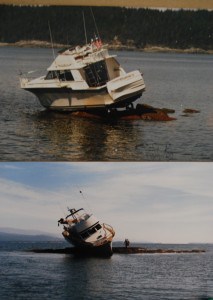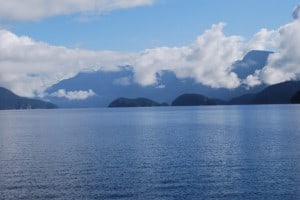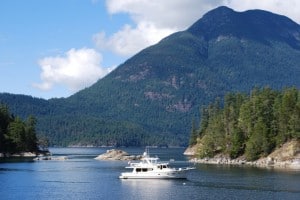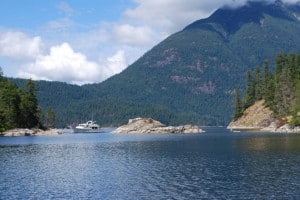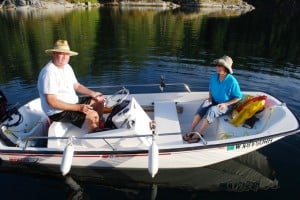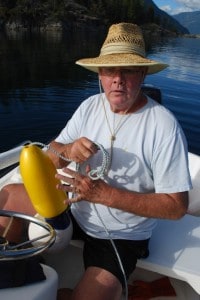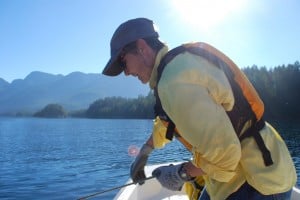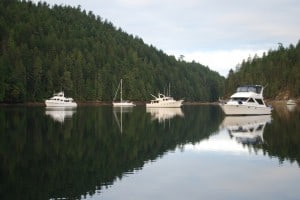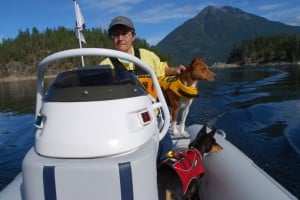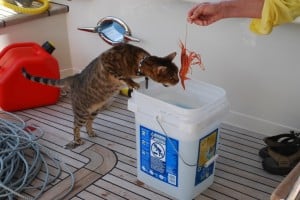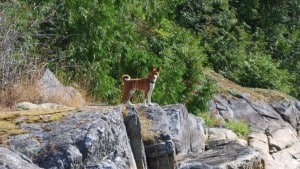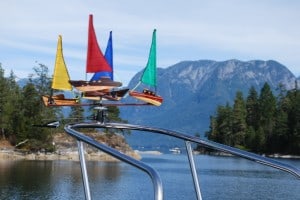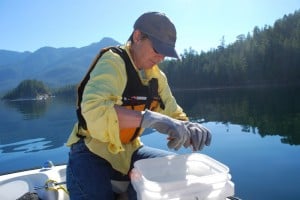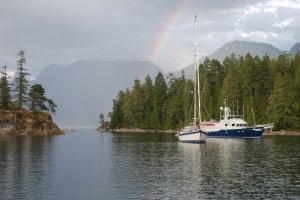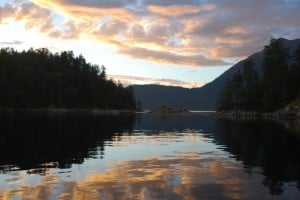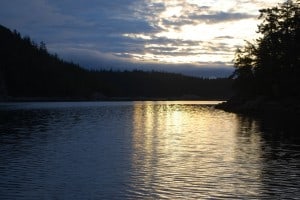Hello all,
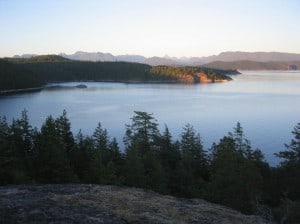
There’s a hill behind the Cortes Island SYC Outstation, with a nice trail up about 200’ to a lookout. It’s nice to hike up there with a bottle of wine for a sunset. The foreground is the southern tip of Cortes Island, with the mountains ringing Desolation Sound in the distance.
Well, we’ve now progressed to the title of hunter-gatherers – with our first real foray into provisions from the sea. Not that we were real successful at it, but luckily, we have good friends with hearts of gold, and helping them with their equipment, they let us share in their catch. More on that later………
Today we’re working our way south on the Strait of Georgia and will be in Nanaimo tonight – and the next 3 days as Kap returns home for her surgeon and PT visits.
(Click on any image to see an enlarged version; if you wish to see our current location, click on Current Location at upper right.)
Monday, August 30– Cortes Bay SYC Outstation to Refuge Cove Marina – 7 Nautical Miles; 1:04 Cruising Time
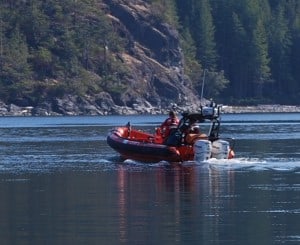
Under some arrangement we aren’t privy to, the SYC provides overnight moorage space on the dinghy dock for a Canadian Coast Guard 3-person inflatable go-fast boat. They must billet the crew somewhere near here, as they come and go at meal times and morning/evening, always friendly, but all business. The boat is about 16’ long, with two 150hp outboard motors on it, and one afternoon I watched them ram the throttles forward just after leaving the dock – and within moments they must have been going over 60MPH. The 2-3 person crew wears orange survival suits, but unlike their U.S. counterparts, we haven’t seen evidence of automatic rifles like we do at Roche Harbor.
The Cortes Bay SYC Outstation is a comfortable place to relax and not watch the world go by, but somehow – as Kap put it – it’s almost too comfortable. After five days there – the last three with the place almost deserted save for us, it was time to leave.
Steve and Shirley on the Couverden – a Fleming 55 owned by Shirley’s 92 year old mother, Pinkie – were now at the SYC Garden Bay Outstation in Pender Harbour (46 miles south of Cortes Bay), having left Pinkie at Port Angeles under the full-time watchful eye of caregivers they’ve hired. The Couverden is based each summer in Sidney, B.C. at a slip they own, and we’d last seen them in late July when we first headed out from Anacortes. Now we were discussing plans via e-mail about meeting up in Desolation Sound, where they could teach us the art and technique of prawning.
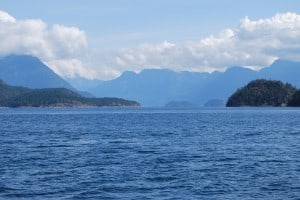
Desolation Sound is quite a large area of open water – probably five miles across – with spectacular towering mountains in the background.
We departed Cortes Bay outstation at 11:10AM and headed across Desolation Sound. As always, we gave a wide berth around the Three Islets and skipped the temptation to take the shortcut on the inside. Interestingly, our Douglass cruising book shows it’s safe to pass on the inside of the Three Islets – and we did it once or twice in Cosmo Place, but now we don’t.
This grounding in the accompanying photo happened in 2009, on a barely submerged rock inside Three Islets near the entrance to Cortes Bay. This is a Royal Vancouver Yacht Club boat (the Royal Van – as it’s called – has an outstation just across the bay from the SYC), and the skipper apparently wasn’t paying close enough attention to his charts as he came through the shortcut. The yacht grounded on the rocks as the tide was going out, and these photos were taken at the subsequent low tide when the rocks were clearly visible – and the yacht is now high and dry as the rocks are 3-4’ out of the water. On the next high tide they refloated the boat, but it very likely was holed (meaning a rock had punched at least one hole in the hull), and the damage was probably somewhere in the six-figure dollar range. These photos are posted in the SYC outstation clubhouse, with a note next to them – “Boat Safely!” Amen.
Once out in Desolation Sound, the seas were calm (< 1’ chop), and we had clear blue skies. The forecast was for increasing wind in the afternoon and rain overnight. Our destination was Refuge Cove, a short 7 nautical mile cruise to the east side of Lewis Channel, taking us a brief hour and four minutes – including some circling time in deep water while we pumped overboard. The primary purpose was to get our fishing licenses at the general store, along with whatever additional provisions we needed for the next week.
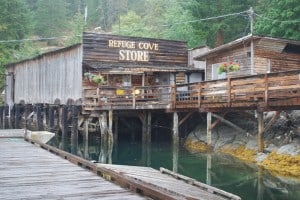
The Refuge Cove Store. It’s mostly perched on pilings along a rocky shore of Refuge Cove. It’s sort of a boardwalk community, with rickety boardwalks on pilings connecting the store to several other one-person businesses and homes. The building to the right is the shower block, where you can get a hot water shower (without a timer) for a loonie (C$1).
Moorage at Refuge Cove can be problematic, as it has a government dock that’s 400’ long, but doesn’t take reservations – and there are a lot of short term boats coming in from the nearby Desolation Sound to get fresh water, fuel, and re-stock their supplies. As we crossed Desolation Sound we could see boats heading in and out of Refuge Cove, so we were hoping the turnover mix would be just right that we’d find moorage. If not, we could always anchor out by the island at the entrance, then come in when we spotted an opening.
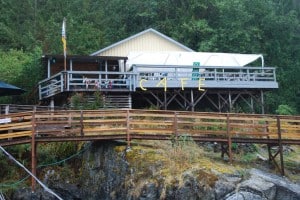
The café up the boardwalk from the Refuge Cove Store. Unfortunately, it was closed because the woman who runs it was over in Campbell River at a medical appointment. The last time we were here we really enjoyed the hamburgers.
We followed two other boats in, one a fine old 50’ Grand Banks named Grand Destiny from Alameda, CA; the other a sailboat that headed for the fuel dock opposite the guest dock (sailboats around this part of the world spend far more time running the iron genoa than they do under sail, so they need diesel fuel too). We were afraid Grand Destiny would take up all of the remaining guest dock, but with the binoculars we could see they were pulling ahead and leaving room for us behind them – and there’d still be enough clearance at the end of the dock where it’s marked Floatplanes Only.
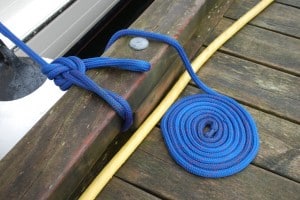
Tying to a bull rail. It’s really simple after you've done it once or twice. With the cleated line coming from the boat, pass the middle of the line under the bull rail (don’t feed the end) so that you have a loop coming from underneath the bull rail. Make the loop about 2’ long by pulling on the loose end. Then pass the loop around the line from the boat and put it through the new loop that you’ve now created. Do that again, and cinch it down. Dirt simple!
As we approached the dock, the Grand Destiny was already tied up and two of its crew were on the dock, ready to help with our lines. After I handed them the bow and stern lines, I jumped onto the dock to finish up tying the bow line. I could see the guy at our stern fiddle and fiddle with tying down the stern line, so I walked back to take over. He’d wrapped the line at least twice around the bull rail and didn’t know how to finish it – and looking embarrassed, said “Sorry, I’m used to tying at cleats, and haven’t yet figured out these bull rails”. Having been there and done that a few years ago, I said, “No worries”, and mentioned that there’s a special technique to it that isn’t intuitively obvious. I’d had the same problem when we first started boating here, but then, I’m definitely not a knot person anyway. It was at Lagoon Cove in the summer of 2007, and Bill Barber watched as I did something similar to this guy – and Bill brusquely said, “Don’t do that! – you make a mess of it and then it’s difficult to get it undone – just bring a loop under the bull rail, then tie a half-hitch twice to the line coming from the boat.” It’s incredibly simple once you see it done, and now I can tie to a bull rail with the best of ‘em.
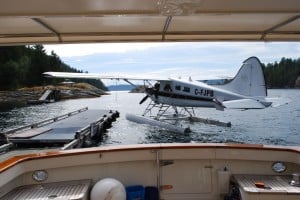
Shortly after we arrived, the first of the day’s floatplanes – a de Havilland Otter, the standard floatplane in these parts – came in with several passengers. This is the closest place for cruising boats in Desolation Sound to pick-up and drop off guests. Most of the floatplane pilots are in their 20s, and they really know their airplanes - when this one docked, he had to overlap his wing with our cockpit, and the tip was less than 5' from our upper deck.
After we settled in and gave Gator, Raz, and ZuZu their “getting here” treats, we went up to the general store. It was better than I’d remembered from our last visit here in 2006 with Jim and Paula on Apt. 5. The produce was fresher and better looking than at Squirrel Cove, they had skim milk, a fairly good selection of cheeses, two aisles of canned goods, and holy of holies . . . they had Cheetos – real Cheetos from the U.S., not the Canadian knock-offs called Cheezies that aren’t very good. I stocked up on some good German sausages for breakfast (it’s my staple breakfast on the boat – heated up in a fry pan, with nothing else). They had tonic water, and that was crucial for finishing off a bottle of gin before arriving back at U.S. Customs. Oh, and a couple more books on PNW cruising that Kap just had to have. Somehow I managed to bring my bill to $97 – plus mooring at the lowest rate in Desolation Sound or the Broughton’s – 60¢ a foot.
This late in the season, and with expectations of only prawning for the few days that we were in Prideaux Haven, we opted for a 5-day Tidal Waters Sport Fishing License – at the non-resident price of C$31 each. The annual license was C$101 each, and that seemed way too pricey for this situation. Next year, when we’re pros at this game we’ll get our licenses at the beginning of our summer cruise and prawn everywhere we go – but for now, it would be just for a quick learning experience (and to see if we really could dispatch those little guys when they’re pulled up).
Throughout the afternoon, we watched a parade of boats come in and depart, and it’s one of those shows where you get to see all manner of docking techniques and boat handling skills. Some of it made us feel like absolute pros – at least we try to make it look like we have some finesse – and one thing we never do is raise our voices.
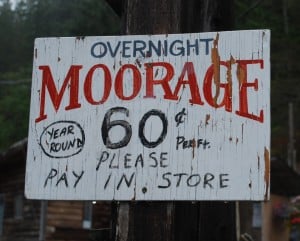
The moorage at Refuge Cove is the cheapest of anywhere we’ve been in Desolation Sound or the Broughton’s – at 60¢/foot. There’s no water or shore power on the docks, so that’s why.
The rain held off, leaving Kap without an excuse to get out of BBQ’ing for dinner – bratwurst on the barbie, while I steamed some fresh broccoli and pan-fried hash browns, with fresh finely diced potatoes (for Kap, these are a medium for lots of her favorite gourmet red sauce – ketchup). We rounded out the evening with an episode of Hamish Macbeth, a BBC Scotland TV series from 1995 that’s proving to be very good. We followed that with an episode of Black Adder – a light note before bed. Netflix is proving a great way to keep DVDs on board Flying Colours, and we time our return shipment of used DVDs for each of Kap’s home visits, and she brings back a new batch.
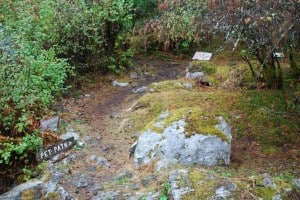
The “pet path” behind the general store. It’s a bit better than the doggy floats in the Broughton’s, but not much. The hillside is so rugged and rocky here that even this little bit of moss-covered rock is better than nothing.
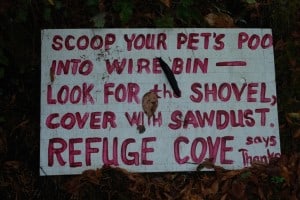
Our “dog poo” instruction board. Note the 7” Pacific Northwest slug inching its way diagonally across the word “wire”.
Tuesday. Near disaster this morning, averted by the great support from Mike Radding of Chuck Hovey Yachts in Newport Beach, CA.
It rained hard overnight – a real soaker – and Kap was up at first light checking the weather. Wind reports from Mercury Shoal (outside Gorge Harbour) all the way down the Strait of Georgia were near-gale force (35 knots), with increasing wind waves. It didn’t seem like a very good day to be out on the water, and we hoped the Couverden gang was listening before they left Garden Bay (in Pender Harbour at the south end of the Strait of Georgia). They e-mailed at 8AM that they were staying put, cozy and curled up with good books. With the rain and low level clouds hanging about, we decided our plan was to stay another night at Refuge Cove.
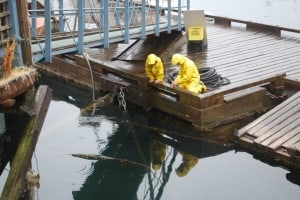
Two young boys try their luck at dock fishing in the morning rain. They were on the inside of the main float dock, in probably not more than 5’ of water, and from the looks of it, you wouldn’t want to eat anything from it. If anything, they might have caught something small that could be used for bait.
At 6AM I made our first latte, then with really sketchy Internet coverage on our broadband link, I settled in to check overnight e-mails and hit a couple of news sites. We fed the dogs and took them for a walk to the “pet yard” behind the general store. On return, it was time for the second latte. Halfway through it, the espresso machine simply stopped! I’d pulled the espresso shots, and was waiting . . . and waiting . . . and waiting for the little green light to come on indicating the water termperature was high enough to steam the milk – it never came on. At first I thought I’d run the machine out of water, but no, the water tank was half full. I swapped the electrical plug to the other side of the wall outlet – no cigar. I checked the main breaker panel in the pilot house to see if the galley outlet breaker had tripped – nope. At that point I was feeling panicky – only someone from Seattle would be panicky when the espresso machine breaks down. The last time this happened was in 2008 during our cruise on Cosmo Place to SE Alaska – we were in Sitka when the espresso machine crapped out, and we had to have Alison air freight a replacement one to us. I always keep a spare one at home, but if that was our problem now it would take a week to get it to us. Damn!
At that point Kap got involved. We plugged my computer into the outlet to see if it was the problem – and sure enough – the outlet was dead. I checked to see if it was one of those with a reset button (called a GFI outlet) – it wasn’t. We got out an extension cord and plugged the espresso machine into an outlet on the other side of the galley – and it worked! Whew! It wasn’t the espresso machine, but the outlet – that’s a helluva lot better!
That still left the problem, though, of why the outlet wasn’t working – while another one on the other side of the galley was working. We tried to check behind it to see if there was a reset on the other side of the wall – no way to tell, without taking out the screwed-in wall of the cupboard next to it. There wasn’t an obvious one under the galley sink below it. Hmmmm, time to call Mike Radding. Mike immediately answered – which was fortunate, as he goes on vacation hunting trips about this time of year – and he immediately suspected that a GFI (ground fault interrupt) had tripped – but where was it? When Fleming wires the boat, they run AC wires throughout the rooms on the boat, and with custom changes of one kind or another on every boat, it sounds like they aren’t consistent in where they place the GFI outlets along the circuits – and therefore, we’d have to search for the GFI-equipped outlet that was wired with our failed outlet. Mike had us check an outlet in the salon, then another one opposite the galley, then one in the pilot house (which is just forward of the galley). None of them were GFI. We searched inside the pilot house instrument panel – no luck. Then Mike had Kap pull up the pilot house settee cushions and look inside the settee housing – there it was. Kap pressed the reset button, and when I checked the galley outlet it was now working. Thanks, Mike! That saved us hours and hours of looking.
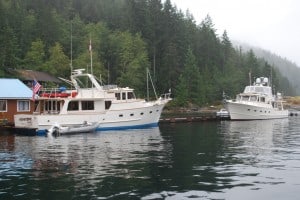
Two Fleming 55s, nose to nose on the dock at Refuge Cove. The Andante, at left, is owned by Robin Gainey of Seattle. She departed on the afternoon Kenmore Air flight to Seattle and is leaving Andante at Refuge Cove for two weeks while she returns home.
Just before noon, as Kap and I were having a Croque Cortes for lunch, I spied a Fleming entering the bay. With the binoculars I saw that it was Andante – a boat that’s registered on the Fleming Owner’s site that I run. It’s owned by a woman from Seattle who comes up every year by herself, single handing the boat! She anchors out in secluded spots for most of the summer, spending her time writing – don’t know if it’s magazine articles, novels, or just what. Her name is Robin Gainey, and according to her web site she owns Gainey Arabians (breeds Arabian horses), and was previously co-founder of the Gainey Vinyard in California. We helped her with her lines, then she told us about her departure that morning from Prideaux Haven – the premier spot inside Desolation Sound. She’s leaving Andante here for two weeks while she returns to Seattle. After talking with her, Kap is quite interested in spending more time with her, talking about her views on handling a yacht such as the Fleming 55. She’s had it for 23 years and seems to really know it well.
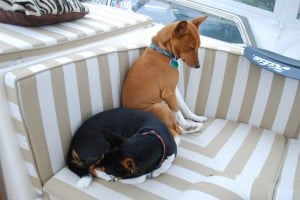
Gator and Raz don’t mind the rain. The enclosed fly bridge is still warm and cozy – a great place to curl up for a snooze.
Off and on between rain showers, Kap worked on the rigging for her emergency anchor retrieval buoy and line. We still haven’t tested our new Rocna anchor – and that will come as soon as we get out to Prideaux Haven. The bottom is reported to be mud, and we’ll be anchoring in only 25-50’ of water, but we’re still concerned there might be old log snags, and given how crowded this place is during the busy summer season, there are probably a few crossed anchor chains still lying down there that an anchor can snag on. The Rocna, developed in New Zealand, is reputed to be the best setting and holding anchor on the market today – and we’re concerned that we just might have difficulty bringing it up. With Kap’s emergency retrieval gizmo, a line is attached through a hole at the top of the anchor fluke, a small round buoy is attached at the other end of the 45’ line, with a small lead weight fastened 10’ down from the buoy to hold down extra line from the surface so it doesn’t snag anyone’s prop. The theory is, if we can’t get the anchor up, we dinghy over to the buoy and pull up the line from the opposite direction, pulling in the opposite direction from where Flying Colours is, and hopefully pulling it free. The buoy also helps us know exactly where our anchor is – lessening the chance that some other boat might lay their scope down over ours – as after a night of swinging in varying winds, it’s hard to tell exactly where your anchor is. (For you non-boating types, the reason for this is, when you’re laying out your anchor, you drop it to the bottom, then “back down” on it laying chain on the bottom, then you set it (i.e., dig it in), and then you lay out your scope – a length of chain that might be 3, 4, 5, or more times the depth that you’re anchor is at – so you might easily be 100-200’ from where your anchor is actually laying on the bottom.) With Kap’s buoy sitting right above the anchor, we can see exactly where it is. That’s the theory anyway. I’ll have more to say about it after we’ve tried it once.
In between, Kap also worked on perfecting the mounting bracket for her sailing whirligig. She epoxied this and that together, until she now has a bracket that looks like it will work perfectly in our burgee mount on the bow. She’s hoping to try it as soon as we’re at anchor in Prideaux Haven.
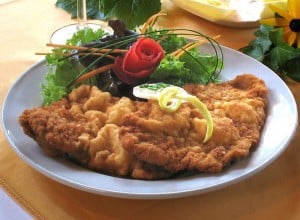
OK, I admit – mine didn’t look quite as good as this, but then I don’t work in a German, Austrian, or Swiss restaurant and practice this a hundred times a day. Rather, I’ve done it maybe a hundred times total, and I think I now have it perfected.
Dinner was one of the trip’s cooking triumphs – wiener schnitzel. I’ve made this a hundred times, but last night was the best I’ve ever done. When I was buying meat back in mid-July at the Cowichan Meat Market in Duncan, the last thing my eye spied in the meat case was labeled Wiener Schnitzel – Pork Leg. They were laid out in thin layers, each weighing barely 4 oz (which seems far too little for a meat lover like me), so I asked for four of them. Usually, I make my Wiener Schnitzel at home from thin-sliced veal scaloppini or chicken breasts that I fillet thinly and then pound to a uniform thickness. I’ve never seen pork leg in our QFC, so I’m definitely going to try The Swine Shop in West Seattle that I learned about from Julie Hearne’s blog the other day. One challenge I’ve always had with schnitzel is getting the breading to stick to it, and not fall off in one big sheet after cooking. For this one, I started prep’ing at noon, first beating a couple of egg yolks with a small dash of milk in a bowl. One at a time, I then dredged a schnitzel piece in flour, pressing it into the meat a bit with my fingers. I then dipped it in the yolk/milk mixture, letting it drain as much as possible before continuing. I then laid it in a pile of already-spiced bread crumbs, again slightly pressing it into the meat. I laid out a double-wide sheet of Saran wrap on the counter, put a wire rack on top, laid the breaded schnitzels on the rack, finally covering it all up with the Saran wrap. Then it was into the fridge for a few hours to let the bread coating set. I cooked them in a sauté’ pan with about 4 tbs of melted butter that I first got very hot. When I turned them with tongs, I could see they were perfectly golden – and the breading adhered perfectly. They were scrumptious with nothing else but fresh lightly steamed broccoli florets on the side. We had a bottle of very nice Italian Pinot Grigio that I picked up in Blind Channel, and surprisingly, it too was perfect!
Why we really like the “common rail” electronic Cummins engines on Flying Colours. The older Grand Banks in the photo has the earlier mechanical engines that have to be warmed up for 10-15 minutes, and it’s putting out a billowing blue smoke cloud. The mechanically-timed injectors that fire the diesel as it squirts into the cylinders are a decades-old technology, and as a result the fuel doesn’t burn cleanly and causes the exhaust smoke. With the newer electronic engines like Flying Colours has – called “common rail” because there’s a single fuel line that feeds all of the electronic injectors – it delivers a precise amount of diesel, at exactly the right time for the maximum compression in the cylinder. As a result, we get absolutely no smoke out of our exhaust, and we’re far less polluting. On our way up Johnstone Strait in August, we followed one particularly bad “stinkpot” – that’s what sailors call the boats with the older engines – for 25 miles, and we could see his trail of black exhaust smoke from at least five miles away.
Wednesday, September 1 – Refuge Cove Marina to Prideaux Haven (Desolation Sound) – 9 Nautical Miles; 1:38 Cruising Time
As the sun went down last night it was still overcast with low hanging clouds and rain in the area. The forecast, though, was for clearing by morning, and that was good news. Sure enough, when we got up this morning we could already see across to Cortes Island, and with blue spots showing through the night’s clouds. We pulled away from the dock at 9:22AM, with blue skies and smooth water.
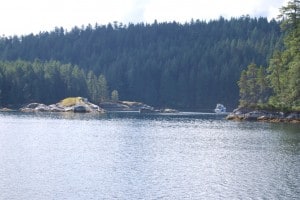
The entrance to Prideaux Haven is almost obscured by rocks. If it wasn’t for good paper charts and chart plotter software you’d be leery about venturing into here.
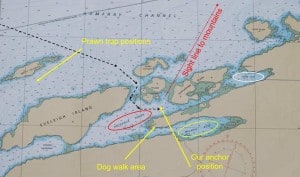
Here’s the chart of Prideaux Haven, the heart of Desolation Sound. I’ve marked our anchor position, our prawning positions, and other details of interest. Our anchor position was definitely the “Chamber of Commerce” location in Prideaux Haven, giving us an unbelievable sightline straight to Mt. Denman – the dominant peak overlooking Desolation Sound. The red circle highlights Prideaux Haven; the yellow circle highlights Melanie Cove; the white circle highlights Laura Cove
We arrived at the entrance to Prideaux Haven at 11AM, hoping it wouldn’t be crowded with too many other boats. At this time of year it shouldn’t be crowded, but with the Labor Day Weekend coming up (it’s the same holiday for Canada too), we didn’t know what to expect. It wasn’t crowded – there were only three boats at anchor, one at each end and one in the middle. We’d never anchored in here before, so Kap motored around as we discussed our anchorage options. Except for a deeper spot just inside the entrance, the depth throughout averages 25-40’ – so it’s hard to go wrong anywhere you decide to drop the anchor. We finally settled on the “Chamber of Commerce” spot, just to the left of the entrance, with a direct view to Mt Denman – Canada’s Matterhorn that rises 6,299’ straight from the water at the head of Desolation Sound.
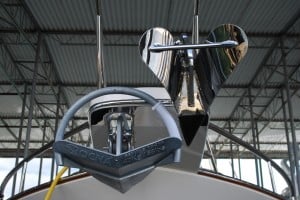
Our new 88 lb Rocna anchor (on the left in the photo). The modified Delta-style anchor that comes with the Fleming 55 was moved to the port side position and fitted with 100’ of anchor chain and 350’ of line as a backup anchor.
With some trepidation due to our low level of experience in anchoring with Flying Colours, we screwed up our courage and dropped anchor in 50’ of water – throwing the emergency anchor release line/buoy into the water just as the anchor was going through the water surface. As soon as the anchor was on the bottom, a few extra feet of chain was let out, then Kap slowly backed the boat as I released another 50’ of chain in preparation for testing whether the anchor was set. Kap popped it in and out of reverse a couple of times and we felt a slight shudder as the anchor dug in and the chain came tight. We were pleased with the “set” of our new Rocna anchor. Kap now backed further as I let out more chain, trying to match her speed as I let it out. When we were at 3:1 scope we stopped and let Flying Colours settle there as we gauged our position. There was very little wind, and none in the forecast for the next three days, so we weren’t very concerned about dragging our anchor in this fairly protected location.
Next came the “snubber”. This is an ingenious and simple device that takes the shock and strain off the windlass (the powered gizmo that lets out the chain and pulls it up – and is very expensive to replace or fix). The snubber also reduces the anchor chain noise dragging across rocks and gravel on the bottom during the night when the changing winds swing the boat in an ever-changing arc. Kap made up our snubber before we left for SE Alaska on Cosmo Place in 2008 – from two 45’ lengths of high-strength line that has a fairly good stretch capability, fastened in the middle with an appropriate hook that will “grab” and hang onto a link in the anchor chain.
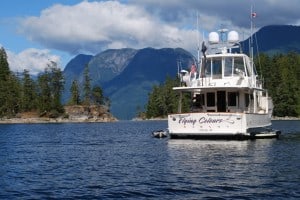
Looking past Flying Colours to the mountains that rise directly from the water at the head of Desolation Sound. Mt. Denman is hidden by cloud at the left.
Once the anchor is set and you feel comfortable with the scope of chain, you climb out to the tip of the bow pulpit (the far pointy end of the boat where the anchor chain drops over the edge). Just below the chain roller you fasten the snubber hook into a link of the anchor chain. The two rope lines attached to it are then threaded back through the forward hawse hole and cleated off at about 15’ from the hook (the bow of Flying Colours is 10’ off the water, so this length will become important in a minute). With Kap at the helm, I then carefully peer over the bow at the anchor line below, then signal Kap to bump the boat forward – at the same time letting out about 10-15’ of anchor chain. The trick is to get the anchor chain to fall inside of the V that is formed by the snubber lines – our solution is to lower the chain until the snubber link is just below the surface of the water, then drive forward as more chain is quickly let out. (If the anchor chain falls outside, you have to keep trying until you get it right.) Once it’s dropping inside the snubber V, you let out enough anchor chain to put the full weight load of the chain coming up from the bottom on the snubber line. Unfortunately, Kap and I were rusty at manipulating the snubber, and it took us several tries to get the bump and chain release just right.
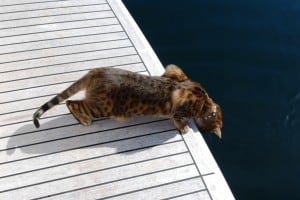
ZuZu is much safer when we’re at anchor. We still watch out for eagles in the area (they have a very distinctive voice, and once you know what to listen for, it’s unmistakable). At the dock we can’t let her roam quite as freely, as she’ll jump onto the dock in an instant. Here, though, she can marvel at all that’s going on in the water below.
We use the snubber on every anchoring, and as we dinghy around anchorage areas we find it surprising how few other boats use one. When we cruised with Jim and Paula on their sailboat, Apt. 5, Jim always used a snubber, and since Kap and I were always given the forward V-berth, not having the chain noise throughout the night was very welcome. It isn’t quite so important on a mud bottom, or when the wind is very light, but when the bottom is gravely or rocky, and the winds are going to be swinging you all night long, you really appreciate it.
Our first order of business was to get the dinghy down, plus both kayaks. Kap hopped in her kayak, and scouted the nearby shoreline for the best places we could beach the dinghy – and “beach” isn’t a very good word here, as it conjures up the image of a sandy shoreline where you can just drive the dinghy up on the sand, then easily step off to let the dogs do their business. Well, that ain’t gonna’ happen in this part of the world! It’s better here in Desolation Sound than in the Broughton’s, but the best you’re going to find is a rocky outcropping, and if it’s good for getting the dinghy in at low tide, it’ll invariably be bad at high tide – and with two trips a day with the dogs, it’ll be low tide at one of them and high tide at the other. Kap came back with a report there was a fairly good spot at the point to the left of the entrance to Melanie Cove. It turned out to be better at high tide, but tricky at low tide due to a rock shelf all around that was barely a foot below the water surface, and that’s too shallow for our outboard motor prop.
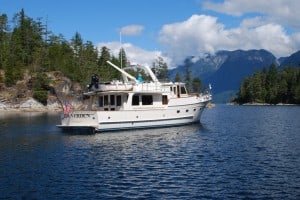
Shirley is at the Couverden helm, while Steve is getting the anchor ready –cruising around to find their preferred anchor location.
Several more boats came in and anchored in quick order, and we were glad we’d arrived when we did. By the time Couverden came into view at just past 2PM, there were about 10 total boats in Prideaus Haven, and a few others had continued into Melanie Cove. They selected a spot a couple hundred yards to the east of us, and just as they began to drop their anchor an idiot with a Grand Banks trawler (flying a U.S. flag) came very close past us at a speed that threw up a wake that rocked us back and forth, pulled up right behind the Couverden, and faster than we’ve ever seen anyone before, dropped his anchor. Shirley and Steve would have been very squeezed now to back down to let out their scope, so after gnashing their teeth for a few minutes at this guy’s inconsideration, they pulled their anchor up – and deciding not to make an issue out of the inexcusable behavior of the boorish Grand Banks guy – went looking for another anchorage spot.
In earlier conversations with Steve, he indicated they had pretty good luck with cell phone coverage inside Prideaux Haven. Sure enough, my iPhone (which uses AT&T and roams in Canada with Telus) and both of our Verizon-based backup phones (which roam with Rogers) had strong signals – it could only be that the crowds are big enough here in the summer, the Canadian cell providers figured there would be enough cell phone traffic to justify the cost of putting in a nearby cell tower (we couldn’t see one). Better still, with cell coverage we also had broadband Internet access with our Verizon boat card, and that gave us WiFi access throughout the boat. It seemed amazing to be in such a remote location, yet still connected to the outside world. Some would find that an annoyance, but I didn’t.
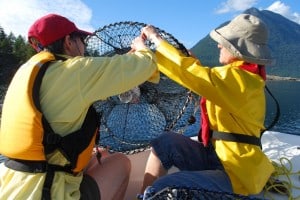
Kap and Shirley ready a prawn pot for a soak. There are strict regulations on the mesh size and the entrance opening size. The bait is in the white cup suspended by bungees in the center.
We got our prawn pots and equipment ready to go. Steve and Shirley had already set their pots out by Mary Island (see accompany photo of the Prideaux Haven chart with locations labeled) on the wayin with Couverden. As soon as they were settled in from anchoring they came by in their dinghy to take us out for our first experience in setting prawn traps. Our equipment included two traps – a collapsible version called Flex Fold that we’d bought from a guy in Sidney, B.C. – leaded sinking line (who’s length we didn’t know, but it was at least 500’), an orange buoy to mark where our traps are, the food pellets given to us by the woman from the Mary E, rubber gloves, and two large buckets. We went in their dinghy because it’s a hard-sided Boston Whaler with lots more room than ours for 4 people. We headed out to Mary Island where they’d dropped their pots, and using a depth sounder Steve motored around until he found just the right spot (whatever that is) – in 310’ of water, about 200 yards from the shore of Mary Island. Steve tied one of our pots to the end of the line, then 50’ from it he tied the second pot – so that we’d have two pots down on the same line. We then added the bait pellets to the plastic container that had been zip-tied inside each pot, plus Steve added some of his super-duper bait mixture (really foul smelling, and I have no idea what’s in it). To increase the scents that attract prawns, Steve opened a can of Carlyle cat food (he swears by this) and we split this between the two containers. Lastly, Steve squirted about a tablespoon of his prized prawning possessions – anchovy oil that he gets at a shop in Victoria, B.C. What a smorgasbord! We dropped the traps over the side, then hand-fed out the line as we drifted away from where the pot was heading for the bottom. We’d let it “soak” for the remainder of the afternoon, and early in the evening return to pull them up to see what we’d caught.
By 6:00PM, our pots had been soaking for 3 hours, so it was time to pull. Once at Mary Island, Steve motored first to the float marking their pots. Shirley hauled the buoy in, then wrapped the line around a pulley mounted to the stainless hand-hold railing on their dinghy. She started the hand-over-hand pulling – this is where heavy rubber gloves come in handy – casually flaking the line onto the deck of the dinghy. They had 500’ of line on their traps, and since we were in only 300’ (or so) of water, there was 200’ of slack line to pull up first. When she tired, Steve took over for the heavier pulling as the pots came off the bottom. Steve gave me a short turn at pulling, and it made me wince at the thought of doing this for our pots. What a job!
Finally, their pots were at the surface – and there was a seemingly small cluster of prawns at the bottom. My first reaction was, “boy, they almost got skunked!” Instead, they were elated, and brought the pot into the dinghy. The second pot was then hauled in, and it too had about the same small number of prawns. The large mesh opening on the top of the pot was loosened, and with rubber gloves on we took out prawns one-by-one, counting them into a bucket filled with sea water. To my amazement, there were about 75 prawns in one pot and about 58 in the other – for a total of over 125 prawns. Wow! If we got that many in our pots the next day I’d be ecstatic!
They quickly reset the bait in their pots, and in just a few minutes time they pushed their pots over the side and let out the line.
Steve and Shirley prefer to dispatch their prawns (that’s my code word for twisting off their heads) right after they put their pots back in. That way they can more easily keep their dinghy clean, and once they get back to Couverden all they have to do is climb aboard and refrigerate the prawns. So, this was going to be our first experience in how to do this – and I’d get to see if I can manage with it.
It didn’t turn out to be as nasty of a job as I’d expected. With the rubber gloves on, it goes a long way towards impersonalizing the fact that you’re twisting off the head of a prawn, killing it in a split second. Besides, we talked over the fact that this isn’t senseless killing, but rather, providing something that we’re going to eat – and that’s just the way life is. The technique was simply to put the head end between the thumb and first finger of the left hand, and put the tail end between the same fingers on the right hand – a slight squeeze with the left hand to hold the head firmly in place, and twist with the right hand. The head was then thrown back in the water, the tail was quickly swished in the water alongside the dinghy, and then dropped in the bucket. With four of us working away at it, The Dispatch took maybe 10-15 minutes.
Next we headed for our pots. Kap and I did all of the pulling, just so we’d experience it. Kap took the first turn – with her wrist situation it would be better for her to pull when it’s just the weight of the extra line. The pull seemed much harder – and much longer – than with Steve and Shirley’s pots – we found out later it’s because we actually had 675’ of all leaded line, whereas they have 500’ of mixed leaded and non-leaded line (in fact, only 100’ of leaded, and 400’ of non-leaded). When the pots finally came to the surface, our expectations were running high! Boy, what a major disappointment to see both of our pots completely empty! Not a single shrimp in either one!
As we motored back, we speculated on could have happened. Our pots had soaked for almost the same time – within an hour of each other. We used a very similar bait to what Steve used in his. We were in almost the same location, at almost the same depth. What could it be? We concluded it must be the pots themselves – but only a few more tries would tell, and if it was the pots, what’s the difference?
When we got back to Flying Colours and Couverden it was 7:30PM and Kap and I were bushed. We hadn’t expected to be out so long, and now we still had to get the dogs ashore one last time for the night. By the time we had dinner and relaxed with an extra glass of wine, it was time to crawl into bed.
Thursday. Kap and I were up at our usual 5:30-6:30 routine and had our first latte. It was already an incredible blue sky day, and we puttered around Flying Colours, but mostly just enjoyed our first day at anchor this cruising season. It has always been our intention to anchor out far more than we’re at a marina dock, but so far this year that just hasn’t worked out. Now we’ve finally done it, and boy were we happy!
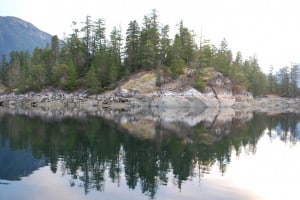
The shoreline inside Prideaux Haven is rugged – with jumbles of large granite boulders rising out of the waters. There are also significant tidal changes – this photo shows a very low low tide.
Immediately after taking the dogs for their shore walk we decided to head out on our own to pull up our pots. If they were empty again, we’d rather be there alone for the disappointment, and who knows, if they were full of prawns, well, we’d share the elation alone. We didn’t have the pulley that came in so handy on Steve and Shirley’s dinghy, but at some point we’d be on our own doing this, so why not start now?
Not having the pulley definitely made a big difference in how hard it was to pull up the pots. Planning for this, Kap had brought along an emergency anchor retrieval kit that had been given to us as a gift by Linda Lewis and Dave Parker – and they swear by its use for prawn pot pulling as well. Kap quickly decided we should try this to finish the pot pull. It isn’t exactly clear what the physics are that make it work, as it’s simply a 10” orange inflated buoy, connected to a plastic sleeve that you thread the pot line through. You tie the surface end of the pot line to the bow of the dinghy, then drive off at about 5 knots. According to the instructions, the speed drives the buoy down the pot line, and with the buoy remaining on the surface it pulls up the bot. Hmmmm! All done with the motor of the dinghy, and not with muscle strength. If it works, I like it.
We quickly got it set up, and with Kap keeping control of the line tied to the bow, I drove the dinghy. It only seemed to work when we drove the dinghy in wide circles, but nevertheless, it worked. In just a couple of minutes the buoy was 300-400’ behind us, on the surface, and that distance represented the amount of line we’d pulled up. As we idled back toward the buoy, we quickly pulled in the line and flaked it on the floor as we’d done on Steve and Shirley’s dinghy.
We decided to pull in the remainder by hand. As the first pot came to the surface, we were stunned – there was one lone prawn in the pot. We pulled in the second pot – and it was totally empty. This can’t be! All that work, and all we got was one lousy prawn! Well, at least he was a big one!
We quickly decided prawning wasn’t so much fun, and why bother putting our pots down again. There was obviously something wrong with what we were doing, or wrong with our equipment. We didn’t re-set the pots, and instead headed directly back to Prideaux Haven. Along the way we decided to drop by the Couverden to show off our prize catch. They were as surprised and dismayed as us, but no one could figure out the difference.
Shortly after we got back, we decided to go back out with Steve and Shirley to help pull their pots. Maybe their catch the previous evening was a fluke, and there weren’t any prawns left. Well, that definitely wasn’t the case. Between their two pots they had 165 prawns!
We spent the remainder of the day just relaxing and playing around. We hopped in the kayaks and toured all around the nearby shores, through waterways between islands that were deep enough for the kayaks to get through – and exposed by about 10’ high jumbles of granite rocks at low tide. At one point a cruising couple from a yacht anchored outside Prideaux Haven motored by in their dinghy – with a plaque on it that said “Doggie Dinghy” – obviously dog people – and they told us about a better dog walk area. It’s on the left side as you look through the rocks towards Mt. Denman, and someone has cleared an approach and landing by dinghy, by removing rocks for about a 5’ swath and stacking them along the side. It’s great at both high and low tide, and easy to get the dogs ashore. What an improvement!
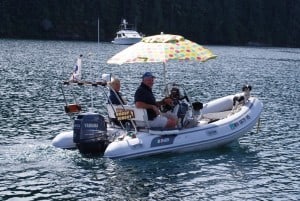
An interesting couple cruised past us several times in their “Doggy Dinghy” – with three yappy floor-mop dogs. They stopped by one time to tell us about a better “goin’ ashore” spot for the dogs. Someone has cleared a dinghy landing area about 5’ wide, and it’s easy access to shore on either high or low tide.
Late in the afternoon we returned with Steve and Shirley to pull their pots. On the way out to the pots, Steve and Shirley were about to set their standard wager on who can guess the total number of prawns they’ll bring up. The loser pays the winner a “loonie”, and the winner has to declare his number first the next time. (A loonie is a Canadian dollar coin – it’s called a loonie because one side has the profile of Queen Elizabeth, and the other is the Canadian national bird, the loon. Their two dollar coin is called a “toonie” – meaning two loonies.). Instead, Steve announced that he and Shirley had decided they were splitting the two pots with us – and we’d flip a coin – the first time to decide the winner of the prawn number guess, and the second toss to decide which of the pots the two teams would get – the first pot pulled in or the second. Kap and I got the second pot.
We all now shared a turn at pot pulling. When they were both up, we had almost 60 prawns in our pot, and Steve and Shirley had a few more. We also had 4-6 rock crabs in each pot, and they were thrown back. Kap and I returned to Flying Colours with a real prawn catch – but only because of the incredible generosity of Steve and Shirley.
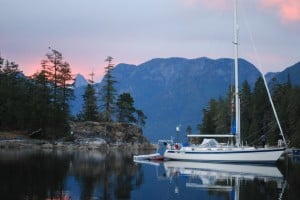
This was our sunset view from the cockpit of Flying Colours on Thursday evening. It doesn’t get much better than this.
Friday. Still wanting to gain as much experience as we could, Kap and I returned with Steve and Shirley for the 9AM pot pull. As we approached the pots, I asked when they were going to set their wager on prawn numbers. Again, Steve started off his little speech about “Shirley and I had a talk”, and announced that “today’s prawn catch was to be gifted to us”. No amount of protest would change the decision, and when we pulled up the pots there were about 90 total prawns in the two pots.
Then Steve decided it was time to go for broke. We’d pull the pots shortly after noon, reset them, and pull them again in the early evening. This time we agreed to splits the two pots between us, Kap and I getting the first pot and Steve and Shirley the second pot. On our return, it wasn’t so bountiful, but nevertheless, we each got about 50 prawns. Ditto for the evening pull.
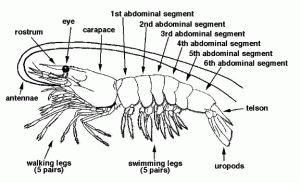
Here’s the anatomy of a prawn, to go with the explanation of shelling that Steve Clark came up with.
By now, I had almost 200 prawns sitting in our fridge waiting to be frozen. Everyone we’ve talked to leaves their prawns in the shell, then freezes them in 2-person meal sized batches in a Ziploc bag filled with some water. That way, you just have to take out one bag, defrost it, and you’re ready for scampi, or whatever. We brought four bags of prawns like this along on Flying Colours that were given to us by Bob and Glenna from the abundant catch they’d gotten in May and June. They were wonderful, and greatly helped me in perfecting the Flying Colours Famous Scampi.
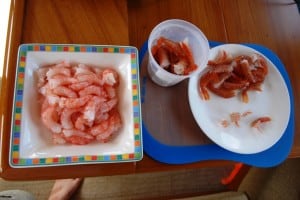
The plastic container in the center has prawns ready to peel; the plate on the left has peeled prawns. They’ll be portioned out in batches of 30 (a dinner for two) for freezing in a pint Ziploc bag.
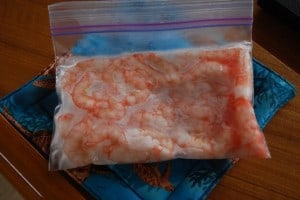
Our freezer on Flying Colours is now stocked with 9 bags of shelled prawns – should keep us in scampi and other good prawn recipes until the end of the trip.
Well, Steve is a pretty analytical guy, and he’s developed a different idea that we think is pretty good. He shells them when they’re still fresh, then freezes just the shelled prawns in meal-sized batches. For that technique to work, though, you have to first cool them down to fridge temperature immediately after bringing them in from the pot – preferably overnight in the fridge – and only then shelling them. Otherwise, it’s very difficult to peel the shell, and you damage the prawn.
So, to shell, you catch your thumb nail under the 1st abdominal segment (at the spot where you twisted the little guy’s head off), then peel around the top and remove it. Many times I also had to do it with the 2nd abdominal segment as well, and that helps remove the swimming legs that seem to have attachment to the body inside. Then you slide your thumb and forefinger down to the last abdominal segment (the prawn size will determine how many segments it has) and give it a slight squeeze. This pops the body out of the tail and the prawn body can then be withdrawn. And the beauty is – it deveins as it’s being pulled out! It took me a while to get the technique sorted out, but now it’s perfected. You then rinse them one last time, put 32 prawns each in a pint-sized Ziploc bag and pop them in the freezer. Just in case, I kept two bags worth unshelled and we’ll have a comparison scampi cook-off to see if one technique works better than the other based on a taste test. If there’s no difference, I’ll go with the shell-before-freeze method, as they’re ready to drop into a recipe that way.
At 6PM we set our prawn pots for the last time, as we were both pulling up anchors in the morning. Kap and I had talked over our plans for the next few days and had decided to head for the SYC Garden Bay Outstation in Pender Harbour. It would be a good place to park Flying Colours with me, Raz, Gator, and ZuZu aboard, while Kap flew home to Seattle for her medical appointments. Her current flight reservation was to fly out of Nanaimo, but we figured that could be easily changed. The weather wasn’t looking good for going down the Strait of Georgia, though, and Steve and Shirley asked what we thought about returning to Cortes Bay with them for a couple of days. We readily agreed.
A rain squall with moderate winds blew through while we were still pulling and setting our prawn pots. It continued off and on throughout the evening, but the forecast was for clearing overnight.
Saturday, September 4 – Prideaux Haven (Desolation Sound) to Cortes Island SYC Outstation – 13 Nautical Miles; 1:47 Cruising Time
It was still cloudy at daybreak; but by the time the sun came up it had cleared a bit and we could see blue sky through a gap in the island hills to the west. High winds were still forecast for the Campbell River area, and that included where we were.
By 8AM we took the dogs for one last walk at very low tide – so low that the passages we’d previously kayaked through were totally dry and the rocks were exposed by about 20’ above the water. Afterwards, we got the dinghy quickly raised to the upper deck, and secured as much of our at-anchor glimp as we could. Then we got a call from Steve and Shirley – they were having inverter problems that made the fridge not work. They were on the phone – here’s where the cell phone access really comes in handy – to Mike Johnson back in Anacortes. Mike manages all of the maintenance for Couverden, and within an hour he had them up and running with a temporary fix that would keep them going until they got back home.
Our expectation was that this last prawn pot haul would not be shared, but Steve and Shirley wouldn’t have any of it – they insisted we take the first pot up and they’d take the second one. Steve’s pot had about five rock crabs in it, but we got a shock when I pulled in our pot – it had an octopus in it, and he’d eaten all but 25 of our prawns. Steve and Shirley had 75 shrimp in their pot – and we figured we’d have had a similar number if it weren’t for the octopus. It took both hands of three of us to get the octopus out of our trap, as he wound his tentacles out through the mesh, and boy, did he hang on. Each tentacle was about 12-14” long, and when I’d grab one with my rubber-gloved hand, the pop of his suckers releasing was a unique sound. His head was about 8” high, and about 5” wide, with a mouth that was about 3” when open. Shirley and Steve had experienced this twice before at Garden Bay this summer, and both times the octopus squirted ink just as they got him back in the water – and luckily, he did the same when we threw him in. My god, he would have made a mess if he’d done it while we were trying to get him out of the pot!
Back at Flying Colours, we were almost ready to raise the anchor. The first 50’ came up easily and clean – it was just hanging in water below us. The rest, though, was caked in mud, and not only did it take a lot of pull on the windlass to get it up, but it was more than our high-powered water jet anchor wash could do to squirt away the mud. We had to get out a hose and pre-wash the chain on the way up, and then the water jet would take care of the rest. It was 11:14AM when we got our Rocna up from it’s first anchoring job. We then idled over to Couverden and waited by them to ensure they were OK getting their anchor up OK.
Once out in Homfrey Channel it was starting to blow – with gusts in the 20-25 knot range. It was kicking up wind waves with whitecaps, and the dogs and cat started to get nervous. As we motored along, I shelled prawns in the salon while Kap drove, but as it got rougher and rougher I decided I should quit. Two soup containers were completed and I now had about four Ziploc packs of 30 prawns each in the freezer. Only five more soup containers to go and the shelling job would be over.
Suddenly, about halfway across to Cortes Island we heard Comox Traffic talking to Pacific Titan on CH 71. Kap recognized the voice as Cap’n Doug Myers, on the tug that we’d gone to SE Alaska on in 2003 and 2005. We called to Pacific Titan on 16, but didn’t get an answer, and figured he must still be too far away. Ten minutes later we heard another traffic call, so we tried again – this time we got him loud and clear. We switched to CH 68 – the chat frequency – and had a good talk with Doug. We haven’t seen him since he dropped aboard Cosmo Place in Ketchikan in June, 2008, although we’ve talked to him a couple of times on the VHF as we’ve passed up and down the Inside Passage.
Couverden arrived at the outstation about 10 minutes ahead of us, pulling forward on the dock so that we could come bow-in behind them. The winds were gusting 20-25 knots as we tried to dock, at a quartering angle on our starboard stern. As Kap fought with the bow and stern thrusters to keep Flying Colours parallel with the dock (and not smack it hard!), I threw bow, stern, and mid-ship lines to Steve, Shirley, and another SYC member waiting on the dock to assist us. Our 16” round fenders are really great in conditions like this, as they’re very good at keeping us off the dock when there’s nothing to do but hit it harder than you’d like. We quickly got the lines secured, then re-positioned ourselves on the dock where we wanted to be.
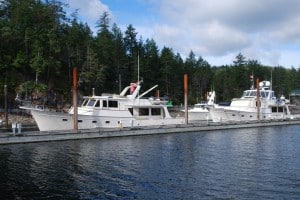
The Couverden (at left) and Flying Colours on the dock at the Cortes Bay SYC Outstation. At 10:42AM when this photo was taken, Steve was standing in the fly bridge of Couverden and he told me the top of the metal pipe piling near the stern of Couverden was about 1’ higher than his head (and Steve’s at least 6’-4”). This is a low-low spring tide.
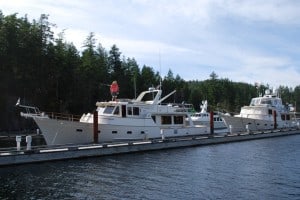
At 3:13PM when this photo was taken we were at a high-high spring tide – the perspective makes the pilings look taller, but they were a little above my height when I walked past – so probably 6’ above the dock.
There were only two other boats at the outstation – a Nordhavn 50 named Seaclusion that was here when we’d left five days earlier, and another, Psyche, owned by a couple from Tucson who are out-of-state members. This is the best time of the year to be here.
In the late afternoon we had a cocktail hour with Steve and Shirley aboard Couverden. Using two bags of fresh-frozen prawns that I brought, Steve cooked up his favorite sautéed version of scampi, with a healthy shot of Drambui splashed in at the last minute (Steve also does a baked version) . It was delicious!
Sunday. This was a laundry day. The outstation has a great laundry room, with three large commercial-sized washers and dryers.
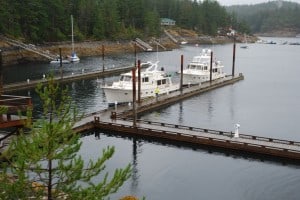
By Monday morning the Couverden and Flying Colours were the only boats left at the outstation. This is a wonderful time to visit – if you want total seclusion, that is.
Monday. The original plan was to depart early and head down the Strait of Georgia for Nanaimo. As usual on departure days, Kap was up at 4:30AM accessing the weather reports with her iTouch. By 6:00AM it was obvious this wasn’t a good day to be going south – with 25 knot winds that would be blowing right on our nose, and a current running against us. It’s already an 8-hour run to Nanaimo from here, and this would make it even longer – not to mention, a very rough ride. ZuZu wouldn’t like that. A decision was made to stay put, as the weather forecast for Tuesday sounds much better. We turned the day into a quiet one on Flying Colours, with a long walk with the Gator and Raz in the afternoon to give them (and us) some exercise. Along the road we spied some blackberry bushes, and they provided dessert for dinner.
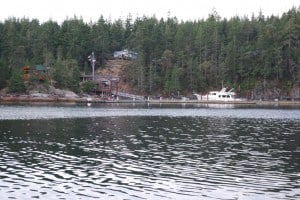
Couverden, alone at the dock, as Flying Colours departs Cortes Bay Outstation for the last time in 2010.
Tuesday. And then there was one……
We’re on our way to Nanaimo.
That’s all for now.
Ron

